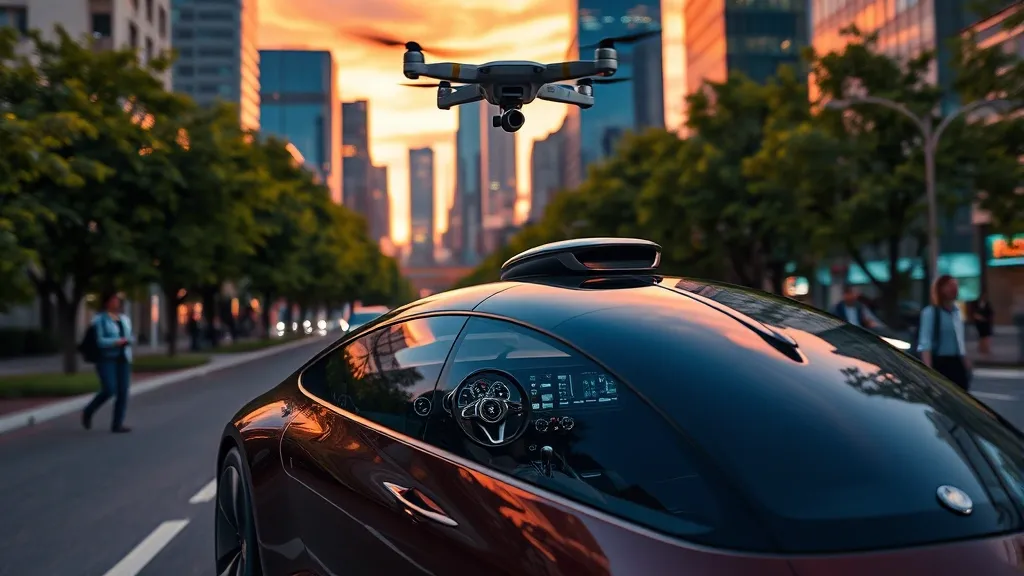The Brain Behind the Wheel: How AI Takes the Driver’s Seat
Alright, let’s dive into the nitty-gritty of what makes self-driving cars tick. When you think about it, these cars are like super-smart toddlers. Just like a kid learns to navigate the world, self-driving cars use AI (that’s Artificial Intelligence for those not in the tech loop) to figure out how to drive. But instead of learning the hard way by bumping into things, they have a ton of sensors and data at their disposal.
So, what’s going on inside these high-tech vehicles? Well, they’re packed with cameras, radar, and LiDAR (which is like radar but way cooler and uses lasers). These sensors work together to create a detailed map of the car’s surroundings. Imagine a 360-degree view where the car can “see” everything—traffic lights, pedestrians, potholes, you name it. It’s like having superhuman vision, but without the spandex suit.
Now, the magic happens when all this data gets processed. That’s where AI steps in, analyzing the information in real-time. Think of it as the car’s brain, deciding when to brake, accelerate, or swerve to avoid that stray dog that just darted into the road. It’s a little like playing a video game, only the stakes are much higher (and you definitely don’t want to hit the reset button).
Machine learning plays a big role here too. The more the AI drives, the smarter it gets. It learns from its experiences, just like we do. If it encounters a tricky intersection where drivers behave oddly, it remembers that for next time. So, in a way, every ride is a lesson. I mean, if only I could learn how to parallel park that easily!
Of course, there are challenges. Weather conditions can throw a wrench in the works—rain, snow, or fog can mess with the sensors. But hey, we humans struggle with that too, right? Ever tried driving in a downpour? It’s like seeing through a shower curtain! But developers are working hard to make these systems more robust, ensuring our future rides are as safe as they can be.
In the end, the combination of sensors, data processing, and machine learning creates a vehicle that isn’t just a bunch of metal and wheels. It’s a complex system that, with time and tweaks, could change the game for transportation. And who knows? Maybe one day, we’ll all just kick back and let our cars do the driving while we binge-watch our favorite shows. Talk about multitasking!
Sensors and Signals: The Symphony of Senses in Motion
So, let’s dive into the fascinating world of sensors and signals in self-driving cars. Honestly, it’s like they’re throwing a party for all the tech geeks out there! These vehicles are decked out with an array of sensors that help them understand their surroundings. Imagine having a sixth sense, but instead of seeing ghosts, these cars are dodging pedestrians and potholes.
At the heart of it all, you’ve got cameras, LiDAR, radar, and ultrasonic sensors. Each of these plays a unique role, kind of like a band where every instrument contributes to the overall sound. For example, cameras are great for recognizing traffic lights and reading signs—basically, the car’s eyes. They can spot a red light from a mile away, which is more than I can say for some drivers out there!
- Cameras: These are the “eyes” of the vehicle, capturing real-time images and video to identify objects, lanes, and traffic signals.
- LiDAR: A fancy term that stands for Light Detection and Ranging. It’s like using a laser beam to create a 3D map of the car’s environment. Super cool, right?
- Radar: This tech uses radio waves to detect the speed and distance of objects, which is crucial for maintaining safe distances from other vehicles.
- Ultrasonic sensors: These are typically used for parking and detecting obstacles close to the car. Think of them as the car’s personal space bubble.
Now, all these sensors generate a ton of data, which the car’s onboard computer processes in real-time. It’s like a constant flow of information, and the car needs to make split-second decisions. Talk about pressure! One moment it’s cruising along, and the next it has to decide whether to brake for a squirrel or risk it. Spoiler alert: the car usually chooses the squirrel.
But, here’s the kicker: all these sensors need to work together flawlessly. If one sensor fails, it could throw the whole system off. It’s like trying to play a song when your drummer is out of sync. That’s why a lot of these self-driving systems have redundancies built in. They’re like the backup singers of the tech world, always ready to step in if something goes wrong.
In conclusion, sensors and signals are the backbone of self-driving cars. They give these vehicles the ability to navigate our chaotic roads. And honestly, it’s pretty mind-blowing to think about how far we’ve come. Who knows, one day we might just sit back, relax, and let the car handle everything while we binge-watch our favorite shows on the way to work!
Mapping the Unknown: How Lidar and Cameras Paint Our Roads
So, let’s dive into the fascinating world of Lidar and cameras. Honestly, it’s like giving self-driving cars a pair of superhero glasses that help them see everything around them. You know, like when you put on those funky 3D glasses at the movies—only instead of a cool animated film, it’s navigating busy streets and dodging pedestrians. No biggie, right?
Lidar, which stands for Light Detection and Ranging (yeah, I know, sounds fancy), uses laser beams to measure distances to objects. Picture this: a bunch of tiny lasers firing out and bouncing back, creating a 3D map of the surroundings. It’s like a super high-tech version of echolocation, but instead of dolphins, we’ve got cars. Pretty neat, huh? This tech helps the car detect everything from curbs to other vehicles, even in low-light conditions. It’s like having night vision but for cars. Who wouldn’t want that?
Cameras are another crucial piece of the puzzle. They provide a more detailed view, helping the car recognize traffic signs, lane markings, and even pedestrians (yes, folks, that means they’re looking out for you!). The combination of these two technologies is what gives self-driving cars their “sight.” It’s like they’ve got a trusty sidekick—Lidar is the strong, silent type, while cameras are more like that friend who never stops talking about what they see.
- Lidar: Great for mapping out the environment in 3D.
- Cameras: Perfect for recognizing objects and understanding visual cues.
But here’s the kicker: it’s not just about having these technologies. It’s how they work together that really counts. The car’s brain (a.k.a. the software) takes all this data and processes it in real-time. Imagine trying to juggle while blindfolded—that’s basically what these cars are doing every time they hit the road. They’ve gotta make split-second decisions based on what they “see” from both Lidar and cameras.
In a nutshell, mapping the unknown isn’t just about high-tech gadgets. It’s about making sure our future roads are safe and efficient. And honestly, if a car can avoid hitting my mailbox on a bad day, I’m all for it! So, here’s to the superheroes of the automotive world, making our roads a safer place one laser beam and camera flash at a time.
The Ethical Dilemma: Can a Car Have a Conscience?
So, let’s dive into the juicy stuff—self-driving cars and their moral compass. It’s wild to think about, right? We’re talking about machines making life-and-death decisions. Think of it like a robot trying to be a superhero. But here’s the kicker: can a car even have a conscience?
First off, let’s get one thing straight. A car doesn’t have feelings or a moral code like we do. It’s programmed to follow rules and algorithms. But when it comes to split-second decisions in tricky situations—like what to do when a pedestrian suddenly darts out in front—things get pretty complicated. Do you swerve and risk hitting another vehicle, or do you stay the course? It’s like one of those choose-your-own-adventure books, but with way higher stakes.
Companies like Tesla and Waymo are trying to tackle this ethical conundrum, and honestly, it feels like they’re playing God a little. They’re designing algorithms that decide who lives and who might not make it. It’s a heavy load, and I can’t help but wonder—what if they get it wrong? Like, what if their idea of an ethical choice ends up being a total flop? Talk about pressure!
- Utilitarianism: This approach says the best action is the one that maximizes overall happiness. So, if a car has to choose between two bad outcomes, it might pick the one that saves the most lives. Sounds good, right? But what if that means sacrificing a single person for a group? Yikes!
- Deontological ethics: This is the “rules are rules” vibe. It argues that some actions are just wrong, no matter the outcome. So, if a self-driving car has to choose between hitting a pedestrian or breaking a traffic law, it might just stick to the law. But then we’re back to the dilemma, aren’t we?
Basically, there’s no one-size-fits-all answer here. As much as I’d love to think that a car could be our ethical buddy, it’s more like a complex puzzle with pieces that don’t always fit together. And let’s be real, who wants to be in a car that has to make these decisions? I mean, I can barely choose what to have for lunch without second-guessing myself!
At the end of the day, the question of whether a self-driving car can have a conscience is more about us as humans than the cars themselves. We need to decide what values we want to instill in these machines. It’s a big responsibility, and honestly, it’s kind of terrifying to think about.



